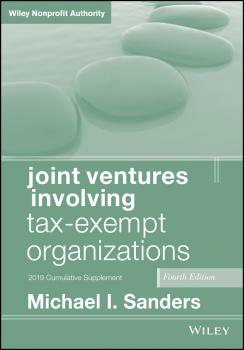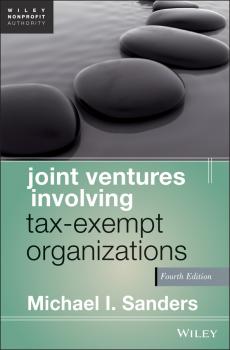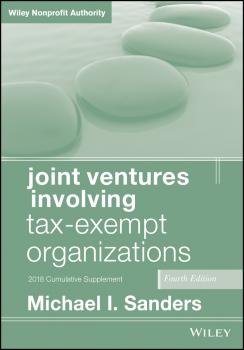ТОП просматриваемых книг сайта:















Michael Sanders I.
Список книг автора Michael Sanders I.Аннотация
Effective strategies for non-profit entities in a profit-based world Joint Ventures Involving Tax-Exempt Organizations examines the procedures, rules, and regulations surrounding joint ventures and partnerships, emphasizing tax-exempt status preservation. Revised and updated to align with changes made to numerous tax codes and laws within the last year, this supplement offers expert interpretation and practical guidance to professionals seeking a complete reference, including an analysis of impact of the “siloing” of the UBIT rules, the new Opportunity Zone Funds which will incentivize investors in designated census tracts, inter alia. Sample documents enable quick reference and demonstrate real-world application of new laws and guidelines. The discussion delves into planning strategies that can be applied to joint ventures and partnerships while maintaining tax-exempt status, and which joint ventures are best suited for a particular organization. Widely accepted business strategies for profit-based entities, joint ventures, partnerships, and alliances are increasingly being used by nonprofits in need of additional financial support in challenging economic environments. This book provides invaluable guidance to appropriate planning and structuring while complying with tax-exemption guidelines. Identify the most appropriate transactions for nonprofit organizations Recognize potential problems stemming from debt restructuring and asset protection plans Reference charitable organization, partnerships, and joint venture taxation guidelines Understand which joint venture configurations are best suited to tax-exempt organizations Joint ventures and partnerships are currently employed by a variety of not-for-profit organizations while maintaining their tax-exempt status. Hospitals, research laboratories, colleges and universities, charter and special-needs schools, low-income housing developments, and many others are reaping the benefits of joint venture participation—but without careful planning and accurate interpretation of current laws, these benefits can be erased by loss of tax-exempt status. Joint Ventures Involving Tax-Exempt Organizations provides practical, up-to-date guidance on realizing the full benefits and avoiding the hazards unique to nonprofit organizations.
Аннотация
A comprehensive, revised, and expanded guide covering tax-exempt organizations engaging in joint ventures Joint Ventures Involving Tax-Exempt Organizations, Fourth Edition examines the liability of, and consequences to, exempt organizations participating in joint ventures with for-profit and other tax-exempt entities. This authoritative guide provides unbridled access to relevant IRC provisions, Treasury regulations, IRS rulings, and pertinent judicial decisions and legislative developments that impact exempt organizations involved in joint ventures. Features in depth analysis of the IRS's requirements for structuring joint ventures to protect a nonprofit's exemption as well as to minimize UBIT Includes sample models, checklists, and numerous citations to Internal Revenue Code sections, Treasury Regulations, case law, and IRS rulings Presents models, guidelines, and suggestions for structuring joint ventures and minimizing the risk of audit Contains detailed coverage of: new Internal Revenue Code requirements impacting charitable hospitals including Section 501(r) and related provisions; university ventures, revised Form 990, with a focus on nonprofits engaged in joint ventures; the IRS's emphasis on good governance practices; international activities by nonprofits; and a comprehensive examination of the New Market Tax Credits and Low Income Housing Tax Credits arena Written by a noted expert in the field, Joint Ventures Involving Tax-Exempt Organizations, Fourth Edition is the most in-depth discussion of this critical topic.
Аннотация
Effective strategies for non-profit entities in a profit-based world Joint Ventures Involving Tax-Exempt Organizations examines the procedures, rules, and regulations surrounding joint ventures and partnerships, emphasizing tax-exempt status preservation. Revised and updated to align with current 2017 Tax Act, this supplement offers expert interpretation and practical guidance to professionals seeking a complete reference, including an analysis of impact of the “siloing” of the UBIT rules, the new Opportunity Zone Funds which will incentivize investors in designated census tracts, inter alia. Sample documents enable quick reference and demonstrate real-world application of new laws and guidelines. The discussion delves into planning strategies that can be applied to joint ventures and partnerships while maintaining tax-exempt status, and which joint ventures are best suited for a particular organization. Widely accepted business strategies for profit-based entities, joint ventures, partnerships, and alliances are increasingly being used by nonprofits in need of additional financial support in challenging economic environments. This book provides invaluable guidance to appropriate planning and structuring while complying with tax-exemption guidelines. Identify the most appropriate transactions for nonprofit organizations Recognize potential problems stemming from debt restructuring and asset protection plans Reference charitable organization, partnerships, and joint venture taxation guidelines Understand which joint venture configurations are best suited to tax-exempt organizations Joint ventures and partnerships are currently employed by a variety of not-for-profit organizations while maintaining their tax-exempt status. Hospitals, research laboratories, colleges and universities, charter and special-needs schools, low-income housing developments, and many others are reaping the benefits of joint venture participation—but without careful planning and accurate interpretation of current laws, these benefits can be erased by loss of tax-exempt status. Joint Ventures Involving Tax-Exempt Organizations provides practical, up-to-date guidance on realizing the full benefits and avoiding the hazards unique to nonprofit organizations.



